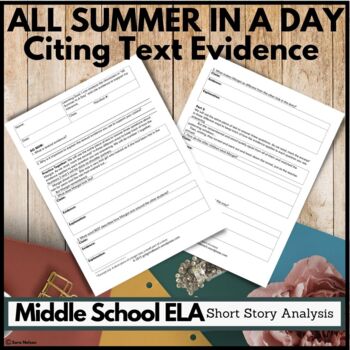All Summer In A Day Cite Textual Evidence Middle School ELA
- PDF
- Easel Activity
What educators are saying
Description
It can be challenging to practice citing textual evidence while ensuring your middle school students are also mastering reading comprehension. This lesson, on Ray Bradbury's short story "All Summer in a Day" contains everything you need to help your students learn to cite textual evidence to support analysis of a short story.
Your students will love having multiple opportunities to practice citing evidence as they analyze the characters in "All Summer in A Day." You will love having everything you need to cover multiple reading and writing standards, allowing you to focus on giving feedback to your students.
Here's what you'll get:
1. Mini lesson for students to go over what textual evidence is, why it is needed and how it is used.
2. I Do: Teacher Models the process of finding evidence to support claims.
3. We Do: Students work together to find evidence to support claims.
4. You Do: Students get 4 opportunities to practice developing claims and finding evidence to support them.
5. Exit Ticket: On their own, using the last excerpt, students find evidence and support a claim about the text.
6. Teacher Answer Key
Your students will get multiple opportunities to practice citing evidence to support claims, all while developing an in-depth undertstanding of the characters in "All Summer in a Day." Through careful modeling and practice, students learn to develop a claim, cite evidence to support the claim and explain their evidence, leading students to produce a 3-4 sentence answer.
There is a print and digital version for distance learning. This lesson plan aligns to CCSS R1 and RL 6.1, specifically, but could be used with any middle school students who need specific support in citing evidence. The lesson follows an I do, we do, you do format, so that by the end of the lesson, students are citing evidence independently. All answers keys are included.
These graphic organizers work well for struggling writers and for students who are just learning to cite evidence. In order to properly execute this lesson, students need to have read and understood “All Summer In A Day.” This lesson, on comprehending "All Summer In A Day" can help them.
This lesson could be shortened, and covered in 60 minutes, or stretched over 2 days to give students ample practice. The teacher copy includes a version with and without sentence starters. The sentence starters are useful for struggling writers who are getting used to how to format a paragraph with direct evidence.
This resource, due to copyright restrictions, DOES NOT include the text to the story. Included on the handout are the first two sentences and last two sentences of each excerpt, to allow for easy location in the text. It is advised that each student have his or her own copy of the text for easy annotation.
TEACHERS LIKE YOU ARE SAYING...
⭐️⭐️⭐️⭐️⭐️"I used this with my seventh graders to show them how to incorporate literary quotes in their writing. They love the story and were very engaged with it. I really appreciated how the graphic organizer chunked each part of the process. I was able to break each part up into mini lessons. It worked great...thank you!"
⭐️⭐️⭐️⭐️⭐️"Great resource to guide students through what can be a challenging text for some! Also a great, simple activity to practice using evidence to support a claim."
⭐️⭐️⭐️⭐️⭐️"I cannot say enough good things about this product. I was observed while teaching this lesson -- it was such a hit with my administrators. Thank you so much!"
--------------------------------------------------------------------------------------------
Other Short Stories
----------------------------------------------------------------------------------------------
Customer Tips:
How to get TpT credit to use on future purchases:
Go to your My Purchases page (you may need to login). Beside each purchase you'll see a Provide Feedback button. Click the button and you will be taken to a page where you can give a quick rating and leave a short comment for the product. Each time you give feedback, TpT gives you feedback credits that you can use to lower the cost of your future purchases. I value your feedback greatly.
Be the first to know about my new discounts, freebies and product launches:
Look for the green star next to my store logo and click it to become a follower. You will now receive email updates about this store.




